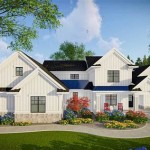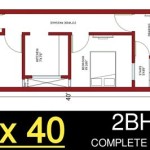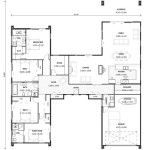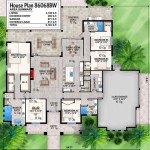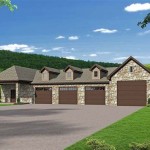2 Bedroom Home Design Plans: A Comprehensive Guide
Designing a two-bedroom home requires careful planning and consideration. Maximizing space, optimizing functionality, and reflecting personal style are crucial factors in creating a comfortable and efficient living environment. This article explores various aspects of two-bedroom home design plans, covering essential considerations for floor plans, interior design, and exterior aesthetics.
Space Optimization and Floor Plan Considerations
Effective utilization of available space is paramount in two-bedroom home design. The floor plan dictates the flow of the house and influences the functionality of each room. There are several key layout styles commonly used, each with its own advantages and disadvantages.
Linear Layout: This layout places rooms along a central hallway. It's a relatively straightforward design that's easy to construct and often cost-effective. However, it can sometimes result in a feeling of confinement, especially in smaller homes. Careful consideration must be given to the placement of windows and doors to ensure adequate natural light and ventilation throughout the hallway and rooms.
Open Concept Layout: This style combines the living room, dining area, and kitchen into a single, large space. Open concept layouts foster a sense of spaciousness and promote social interaction. They can also be more energy-efficient, as heating and cooling can circulate more freely. However, this design requires a good soundproofing strategy, as noise can travel easily throughout the open area.
Split Bedroom Layout: This design places the bedrooms on opposite sides of the house, providing increased privacy for occupants. This is particularly useful when one bedroom is occupied by adults and the other by children, or when roommates share the home. The central living area acts as a buffer zone, minimizing noise transfer between the bedrooms. This option often necessitates a slightly larger footprint to accommodate the separated bedroom wings.
When designing the floor plan, the orientation of the house should also be taken into account. Sunlight exposure, prevailing winds, and views from the windows are important factors to consider. Strategically positioning windows and doors can maximize natural light and ventilation, reducing the need for artificial lighting and air conditioning.
Furthermore, the size and shape of each room should be carefully considered. The master bedroom should typically be larger than the second bedroom, and should ideally include an en-suite bathroom and walk-in closet. The living area should be large enough to accommodate comfortable seating and entertainment equipment. The kitchen should be designed for efficient workflow, with adequate counter space, storage, and appliances.
Finally, consider the future needs of the occupants. A two-bedroom home might need to accommodate a growing family or aging in place. Designing with flexibility in mind can ensure that the home remains functional and comfortable for many years to come. This may involve incorporating features such as wider doorways, grab bars in bathrooms, or a convertible space that can be used as a home office or guest room.
Interior Design Elements: Enhancing Comfort and Style
The interior design of a two-bedroom home plays a crucial role in creating a comfortable and aesthetically pleasing environment. The selection of colors, materials, furniture, and lighting should be carefully considered to reflect the occupants' personal style and enhance the overall functionality of the space.
Color Palette: The choice of colors can significantly impact the mood and atmosphere of a room. Light and neutral colors can make a space feel larger and brighter, while darker colors can create a sense of warmth and intimacy. A cohesive color palette should be used throughout the house to create a sense of harmony and flow. Accent colors can be used to add visual interest and personality to each room. It is beneficial to introduce a unified base color throughout the home, then accent with different hues in each room.
Materials and Finishes: The selection of materials and finishes should be based on durability, functionality, and aesthetics. Hardwood flooring is a popular choice for living areas and bedrooms, while tile is often used in bathrooms and kitchens due to its water resistance. Countertops, cabinets, and fixtures should be chosen to complement the overall design style of the home. Consider the ease of maintenance when selecting materials. Durable materials that are easy to clean can save time and effort in the long run.
Furniture Selection: Furniture should be chosen to fit the scale of the room and to maximize space utilization. Multifunctional furniture, such as sofa beds and storage ottomans, can be particularly useful in smaller two-bedroom homes. Choosing furniture with clean lines and a minimalist design can help to create a sense of spaciousness. Consider the placement of furniture to ensure that the flow of traffic is not obstructed.
Lighting: Proper lighting is essential for creating a comfortable and functional living environment. A combination of natural and artificial lighting should be used to illuminate each room. Natural light should be maximized by strategically placing windows and skylights. Artificial lighting should include ambient lighting (general illumination), task lighting (for specific activities), and accent lighting (to highlight architectural features or artwork). Layering lighting creates depth and interest within a space. Dimmers are a worthy investment, giving control over light levels and setting the mood.
Accessories: Accessories such as rugs, curtains, pillows, and artwork can add personality and visual interest to a room. Choose accessories that complement the overall design style of the home. Avoid cluttering the space with too many accessories, as this can make the room feel smaller and more chaotic. Thoughtfully curated accessories can elevate the design and create a comfortable, inviting atmosphere.
Integrating smart home technology can enhance the functionality and convenience of the home. Smart lighting, thermostats, and security systems can be controlled remotely, allowing occupants to customize their living environment and save energy. These features can be integrated seamlessly into the interior design, adding a touch of modernity and sophistication.
Exterior Design Considerations: Curb Appeal and Functionality
The exterior design of a two-bedroom home plays a significant role in its overall appeal and functionality. The architectural style, landscaping, and outdoor living spaces should be carefully considered to create a cohesive and inviting exterior.
Architectural Style: The architectural style of the home should be chosen to complement the surrounding environment and reflect the occupants' personal preferences. Common architectural styles for two-bedroom homes include ranch, cottage, contemporary, and craftsman. Each style has its own unique characteristics and features. For example, ranch-style homes are typically characterized by their low-pitched roofs and horizontal layout, while cottage-style homes often feature steeply pitched roofs, dormers, and decorative details.
Landscaping: Landscaping can significantly enhance the curb appeal of a home. Trees, shrubs, flowers, and lawn can be used to create a visually appealing and inviting exterior. Consider the climate and soil conditions when selecting plants. Low-maintenance landscaping can reduce the amount of time and effort required to maintain the yard. A well-designed landscaping plan can also help to conserve water and reduce energy consumption.
Outdoor Living Spaces: Outdoor living spaces, such as patios, decks, and porches, can extend the living area of the home and provide opportunities for relaxation and entertainment. The design of outdoor living spaces should be based on the occupants' lifestyle and preferences. A patio or deck can be used for outdoor dining and socializing, while a porch can provide a sheltered space for relaxing and enjoying the views. Consider incorporating features such as outdoor kitchens, fireplaces, and seating areas to create a comfortable and functional outdoor living environment.
Exterior Materials: The choice of exterior materials should be based on durability, aesthetics, and cost. Common exterior materials include siding, brick, stone, and stucco. Each material has its own advantages and disadvantages. Siding is a relatively inexpensive and low-maintenance option, while brick and stone are more durable and aesthetically pleasing. Consider the climate and local building codes when selecting exterior materials. Ensure that the materials are weather-resistant and energy-efficient.
Roofing: The roofing material should be chosen to protect the home from the elements and to enhance its overall aesthetic appeal. Common roofing materials include asphalt shingles, tile, and metal. Asphalt shingles are a relatively inexpensive option, while tile and metal are more durable and long-lasting. Consider the climate and local building codes when selecting roofing materials. Ensure that the roofing is properly installed and maintained to prevent leaks and other damage.
Windows and Doors: Windows and doors play a crucial role in the energy efficiency and aesthetic appeal of a home. Energy-efficient windows and doors can help to reduce heating and cooling costs. The style of windows and doors should be chosen to complement the architectural style of the home. Consider the size and placement of windows to maximize natural light and ventilation. Ensure that the windows and doors are properly sealed to prevent drafts and leaks.
Addressing aspects such as proper insulation and ventilation are vital for energy efficiency and indoor air quality. Well-insulated walls, ceilings, and floors can reduce heating and cooling costs and improve the comfort of the home. Proper ventilation can help to remove stale air and moisture, improving indoor air quality and preventing mold growth. Consider incorporating energy-efficient appliances and fixtures to further reduce energy consumption.

649 Sqft Low Budget 2 Bedroom Home Design And Free Plan From Bee S Kerala Plans House Bungalow Floor

2 Bedroom House Plan Examples

2 Bedroom House Plan Lc70c Plans Garage

12 Simple 2 Bedroom House Plans With Garages Houseplans Blog Com

2 Bedroom House Plan Examples

500 Best 2 Bedroom House Plans Ideas In 2024 Small Floor

Modern 2 Bedroom House Plan 61custom Contemporary Plans

Low Cost 2 Bedroom House Plan 70sqm Floor Plandeluxe

2 Bedroom House Plans Inhouseplans Com

Unique Small 2 Bedroom House Plans Cabin Cottage

